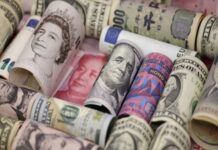The dollar surged and everything else was blown away on Thursday as emergency central bank measures in Europe, the United States and Australia failed to halt a fresh wave of panic selling.
“There is no buyers, there’s not much liquidity and everyone is just getting out,” said Chris Weston, head of research at Melbourne brokerage Pepperstone. Stocks, bonds, gold and commodities fell as the world struggles to contain coronavirus and investors and businesses scramble for hard cash. US stock futures were a hair’s breadth from hitting session down limits. The growth-sensitive Australian dollar was crushed 4% to a more than 17-year low.
Nearly every stock market in Asia was down and circuit breakers were hit in Seoul, Jakarta and Manila. Traders reported huge strains in bond markets as distressed funds sold any liquid asset to cover losses in stocks and redemptions from investors.
Benchmark 10-year sovereign bond yields in Australia, New Zealand, Malaysia, Korea and Singapore and Thailand surged as prices tumbled. Gold fell 1% and copper hit its downlimit in Shanghai. MSCI’s broadest index of Asia-Pacific shares outside Japan fell 5% to a four-year low, with Korea and Hong Kong leading losses. The Nikkei fell nearly 1%, the ASX 200 nearly 3%, while the Kospi lost 8% and the Hang Seng 5%.
“We are in this phase where investors are just looking to liquidate their positions,” said Prashant Newnaha, senior interest rate strategist at TD Securities in Singapore.
Meanwhile, the virus outbreak has worsened. Italy on Wednesday reported the largest single-day death toll increase from coronavirus since the outbreak began in China in late 2019.
It has killed more than almost 9,000 people globally, infected more than 218,000 and prompted emergency lockdowns on a scale not seen in living memory.
JP Morgan economists forecast the U.S. economy to shrink 14% in the next quarter, and the Chinese economy to drop more than 40% in the current one, one of the most dire calls yet as to the scale of the fallout. “There is no longer doubt that the longest global expansion on record will end this quarter,” they said in a note. “The key outlook issue now is gauging the depth and the duration of the 2020 recession.”
Investors will be parsing U.S. weekly jobless figures due at 1230 GMT, and in the weeks to come to gauge the depth of layoffs.
SELL EVERYTHING
The selloff followed an attempt at stabilising in morning trade, with an ECB pledge to buy 750 billion euro ($820 billion) in bonds through 2020 offering some support.
In the afternoon the U.S. Federal Reserve promised a liquidity facility for money market mutual funds.
The Reserve Bank of Australia also cut interest rates to a record-low 0.25% and announced an historic foray into quantitative easing after at an out-of-cycle meeting.
But as with previous massive stimulus measures already announced by central banks around the world, it offered little salve to dire sentiment.
“This is about the impact on demand and the disruption of global supply chain…it is not speaking directly to the key problem for markets,” said Michael McCarthy, chief market strategist at brokerage CMC Markets in Sydney.
In currency markets, everything except the dollar and the euro collapsed. Sterling fell 1% to $1.1490. The yen fell 1% to 109.16 per dollar. The New Zealand and Australian dollars each fell more than 4%. US 10-year Treasuries, usually a haven in times of turmoil, rose through the session, following their steepest two-day selloff in nearly 20 years on Tuesday and Wednesday. Oil steadied after an overnight plunge to an 18-year low in Asian trade, with U.S. crude last up 6.5% to $21.70 and Brent up 34 cents to $25.22.
“I’d say the market is uninvestable at this point,” said Daniel Cuthbertson, managing director at Value Point Asset Management in Sydney. “Until we get a containment of global contractions, the market is just going to be directionless.”























